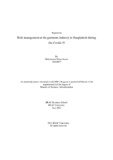Risk management at the garments industry in Bangladesh during the Covid-19

View/Open
Date
2021-07Publisher
Brac UniversityAuthor
Imam, Muhammad HasanMetadata
Show full item recordAbstract
Bangladesh was once recognized as the "bottomless basket." It has now set up itself as a land of miracles. When the major exporting commodity, golden jute, began to lose its shine, the garments industry stepped in to fill this gap. After China, we are now the second-largest clothing exporter with a high brand value named Made in Bangladesh. However, it is a matter of great regret that incidents like Rana Plaza and Tazreen Fashion have exposed us to international criticism. Bangladesh lacks the proper laws and regulations to reduce any risks that might endanger the country's future glory. There are different kinds of risks that may create problems during the Covid-19 like financial risk, supply chain risk, operational risk, and technological risk, etc. The garment workers are the ones who suffer the most because of the Covid-19. The owners began to lose work orders, and they were unable to pay their credit. To avoid such risks, the owners have no savings. They were too busy to make personal assets in different countries around the world, not minimizing risk. Even the owners are involved in many types of criminal activity such as tax evasion, excessive imports, and money laundering. The government is attempting to combat this risk by providing a stimulus package. Hiring experienced management, reforming the BGMEA's responsibilities, and creating strong trade unions are all effective ways to reduce this risk.
